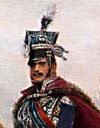The local Dak-Kon convention is coming up on October 13-14, where I will be running a FPGA game of Maloyaroslavets.
In preparation for that game, and to exhibit some tabletop minis game action, I ran a FPGA game of Quatre Bras at the Games and Grounds location for the game expo.
I ended up having just the one opponent, she was most active in the choices she made for the British side in the battle.
For the start she rolled a "1" for the game start = which meant that we were doing something very a-historical in that Ney was going to get most of a day to make the battle go for the French side, which I played.
 |
| Pire's Light Cavalry of II Corps |
From the start, the light cavalry of II Corps, simply refused to budge. No matter what I did the die rolls kept coming up with a result of under 6 or "hold" orders.
While the rest of the French forces under Ney moved very well, in fact the first turn ended up having all 4 'pulses' - meaning that the French got to slam into the Duch forces under the command of Orange virtually unopposed!
 |
| Guard of the Brunswick Corps forced to hold against Cuirassier and Carabiniers |
The Duke of Brunswick did arrive, though, along with Wellington. Only this time they were immediately used to plug up the allied left, now being pressed hard by the Heavy Cavalry of Kellerman.
 |
| Kellerman's heavy Cavalry get a breakthrough on the French right |
|
The dice did not create an 'end game' on turn three so on went the battle, now Picton had arrived, just in the nick of time to check a total rout in the center and allied right.
 |
| Chaos in the center |
The Dutch force had totally been destroyed, there was a moment when the Prince of Orange had made an effort to 'grab the lapels' of Perponcher, his division had rolled a "12" meaning that they were going to attack - something that had happened already and left Chasse's division destroyed. The roll for Orange was a "3", meaning he was trying to retreat - something that would have been smart at that point in the battle. Especially since the Dutch divisions, both of them, ended up destroyed totally at the end of this battle.
 |
| the view from the allied right from the Prince of Orange's HQ |
No matter what Picton did in the center, the fact that the Brunswick corps was totally routed and the allied left had collapsed made the French victory certain. With the time just past mid-afternoon (turn 4) and the roads cut for any more arriving troops, Wellington's dice came up to retreat and end the battle. Picton would have to form the rear guard, likely surrendering the Landwher brigade under his command as the French moved to invest the town of Quatre Bras, a clear victory for Ney!
Oh only if he had started at dawn that day...
 |
| Picton cannot save the day ... |





































































































